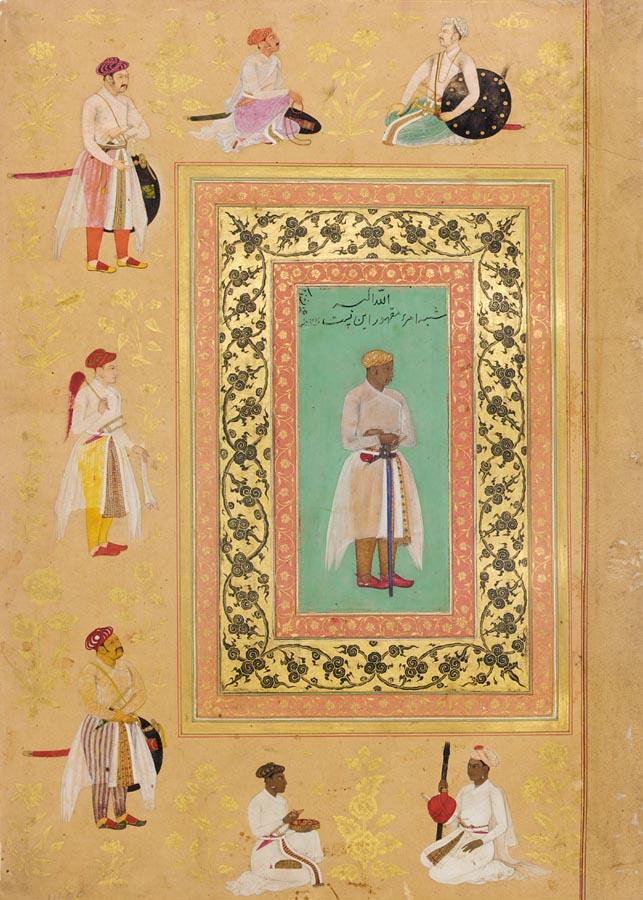

A painting attributed in Jahangir's own handwriting to Bishin Das, c.1624
Source: http://search.sothebys.com/jsps/live/lot/LotDetail.jsp?lot_id=4DV92
(downloaded Mar. 2005)
"PORTRAIT OF AMR SINGH OF MEWAR, ATTRIBUTED IN THE HAND OF THE EMPEROR JAHANGIR TO THE ARTIST BISHIN DAS AND DATED A.H. 1034/A.D. 1624, VERSO WITH CALLIGRAPHIC PANEL SIGNED BY MIR 'ALI, IRAN, 16TH CENTURY, MUGHAL, INDIA, CIRCA 1645-50. Measurements note: panels 23.5 by 16.5 and 14cm. leaf 38.5 by 27.5cm.
DESCRIPTION: gouache heightened with gold on paper, the recto with central portrait on mint-green ground, bordered by alternating bands of foliate motifs and cloud scrolls in black against a gold ground, within plain gold outer border, on buff leaf painted with seven figures and floral sprays in gold, verso with 5 lines of elegant black nasta'liq calligraphy signed by Mir 'Ali, in cloud bands reserved on gold with scrolling foliate motif in colours, margins with floral sprays in colours highlighted with gold.
CATALOGUE NOTE: This leaf is derived from the so-called "Late Shah Jahan" album, a significant collection of poetry and portraits, leaves from which give a unique insight into contemporary Mughal politics and artistic traditions. The album is thought to have been taken as booty from Delhi by Nadir Shah in 1739. From the Persian imperial collection, during the nineteenth century, around a hundred leaves from the album made their way to Paris via Russia and the hands of an Armenian dealer, where they were dispersed in the early twentieth century by Demotte. The album title is derived from the period in which it was compiled. It is thought to have been assembled in circa 1645 - 50 due to the numerous portraits of seventeenth-century nobles and of the elderly Shah, and the absence of royal portraits depicting later rulers. The album pages share several features, such as the borders bearing portraits that are often related to the central figure, or floral sprays in colours and gold, as well as the ornately decorated calligraphic panels.
The Mughal emperors of the seventeenth century were avid collectors of calligraphy from past eras and Mir 'Ali of Herat was the most acclaimed Persian calligrapher of the sixteenth century, whose works were highly sought after. Calligraphic pieces and some earlier portraits were often assembled into albums, combined with miniatures by the foremost masters of the day and embellished with finely decorated borders. This approach was particularly popular at the Mughal court, where Shah Jahan (r.1628-58) commissioned several such albums from the court atelier. The present page is an excellent case in point.
The calligrapher Mir 'Ali studied under Zayn al-Din Mahmud and Sultan 'Ali al-Mashhadi. He was employed at Herat until 1528 when he was taken by the conquering Uzbek warlord 'Ubayd Khan to Bukhara, where he stayed until he died. The year of his death has not been firmly established, but different sources mention 1533, 1544 and 1558. He was highly esteemed in his own day and Qadi Ahmad tells us that he "carried off the ball of pre-eminence and superiority, for in laying down the foundations of nasta'liq he was the initiator of new rules and of a praiseworthy canon..." (Minorsky 1959, p.126).
As with lots 4 and 5 of the Berkeley Trust Collection sale held in these rooms 12 October 2004, the hand of the "Master of the Borders" is discernible in the confidence and quality of the decorative features on the verso. The refinement of individual petals, leaves and stems bordered in gold suggests the work of a master. Indeed, according to some scholars, such borders "rank among the highest and most sophisticated works of art created under the emperor's aegis." (Welch and Welch 1982; no.73, pp.220-222). It is astonishing that any artist could imbue illustrations on so small a scale with such naturalism, grace and technical precision.
The subject of the miniature, Amr Singh, was defeated by the forces of Prince Khurram - later Shah Jahan, in his father's ninth regnal year. Amr Singh's final capitulation came after the Mughal prince stationed his forces at strategic points along the Mewar borders and led a series of crippling attacks against the Rana's army. As was the tradition of the rajas, Amr pledged his son in service to the Mughals and paid homage to the young Jahan by presenting him with famous jewels, elephants and horses. In the Jahangirnama, the eponymous Shah proudly recalls that, "as a sign of favour, my son came forward, and when the Rana grasped my son's leg and asked forgiveness for his offences, my lucky son took his head in his lap and consoled him in such a way that his distress was soothed. He awarded him a sumptuous robe of honour, a jewel-studded sword, a horse with a jewelled saddle and a royal elephant with silver trappings." (Thackston 1999, p.165). The long-standing animosity between the two dynasties and the real threat Mewar poised to the Mughals, is captured in the relief expressed by Jahangir in his unusual addition of "Allahu Akbar" to the inscription on this portrait.
The artist that Jahangir attributes the painting to is Bishin Das, whose skill at capturing likeness in portraiture was so highly regarded that he was despatched by the Shah with the Mughal embassy to Safavid Persia. Indeed Jahangir honours the artist in his memoirs by recording that "Bishin Das... was unequalled in his age for taking likenesses." Bishin Das flourished from circa 1589 to 1650 and was also notable for his convincing group arrangements and the individuality of his female figures. A further page by Bishin Das included in the Late Shah Jahan Album is located in the Museum of Fine Arts Boston. However it differs from the present example in that it is a group scene set in a naturalistic landscape and lacks the date and inscription in Jahangir's hand (Okada 1992, p.158)."
== Indian Routes index == Indian Routes sitemap == Glossary == FWP's main page ==